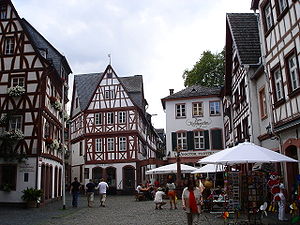Cherry orchard (Mainz)
The cherry orchard is a half-timbered square in the old town of Mainz . Cultural features are half-timbered house lines placed in parallel , which are connected by the alley along the "Weihergarten".
Already in 1329 the place existed as "in the cherry orchard". The name comes from the spring "Kirschborn", which originated there at the old Rochushospital. It was part of the Nova Civitas settlement expansion in the 13th and 14th centuries and was fairly densely populated, as the Sweden plan from 1625/26 shows. At the end of the 16th century, Johann Albinus ran a printing press founded by Friedrich Hewmann (Heumann) in the house "zum Sewlöffel" (Saulöffel) in the cherry orchard.
Initially, the cherry orchard was a closed square that only opened roughly the width of a house to what was then Augustinergasse. It was part of the immunity of the Mainz cathedral chapter . The architecture of the houses dates from the 15th to 18th centuries. The alley, which is now called “Kirschgarten”, was called “die kleine Schöffergasse” in the 16th century. During the French administration at the time of the consulate and the First Empire, the square was referred to as Jardin des cerisiers on the city map . The lower part of the Kirschgartengasse was only expanded to its present location at the end of the 18th century. In this context, a connection to Schönbornstrasse was created. 1976 to 1979 it was extensively renewed, whereby the half-timbering was also exposed.
On September 3, 1932, the Mainz Beautification Association donated the Kirschgartenbrunnen (also called: Marien or Madonnenbrunnen) to replace an older iron fountain, which is still on the square today. The red sandstone required for this was taken from the broken ornamental structures of the road bridge . On this fountain is a copy made by Jean Sauer of a statue of the Virgin Mary of Harxheim , called the Harxheim Madonna, at its base is a relief by the sculptor Carl Moritz Hoffmann. It shows the Blasius Chapel , which formed the entrance to the cherry orchard until 1803.
Zum Aschaffenberg , built around 1500, is the oldest half-timbered house in Mainz that is still partially preserved today.
At the corner of the house "Zum Beimburg" (house number 19) are the remains of a tree stump. However, this is not, as many have said, a cherry tree trunk (from an earlier cherry garden!), But the almost petrified remnant of an oak or a similar tree.
Kathinka Zitz - alias Tina Halein - a writer, was born in 1801 during the French consulate in Kirschgarten. A footpath marked “Kathinka-Zitz-Weg” reminds of her, which leads past the house where she was born to Weihergartenstrasse.
literature
- Do you know old Mainz ?, The cherry orchard, series of images by BHF-Bank, image no. 11, circa 1975
- Wilhelm Huber: The Mainz Lexicon. Hermann Schmidt, Mainz 2002, ISBN 3-87439-600-2 .
Web links
- Historic Mainz: The Cherry Orchard ( Memento from April 1, 2015 in the Internet Archive )
- Stairway To Heaven "Flash Mob Becomes Internet Hit 14 million people have so far watched the video on the Facebook page of New York's" Superstar Magazine ".
Individual evidence
- ^ Otto Mühlbrecht: Albinus, Johann . In: Allgemeine Deutsche Biographie (ADB). Volume 1, Duncker & Humblot, Leipzig 1875, p. 222.
- ↑ Jakob Franck: Jordan, Peter . In: Allgemeine Deutsche Biographie (ADB). Volume 14, Duncker & Humblot, Leipzig 1881, p. 511.
Coordinates: 49 ° 59 ′ 50.5 ″ N , 8 ° 16 ′ 24.8 ″ E

